Evaluation of Potential Risk
VerifiedAdded on 2022/08/19
|14
|1937
|16
AI Summary
Contribute Materials
Your contribution can guide someone’s learning journey. Share your
documents today.
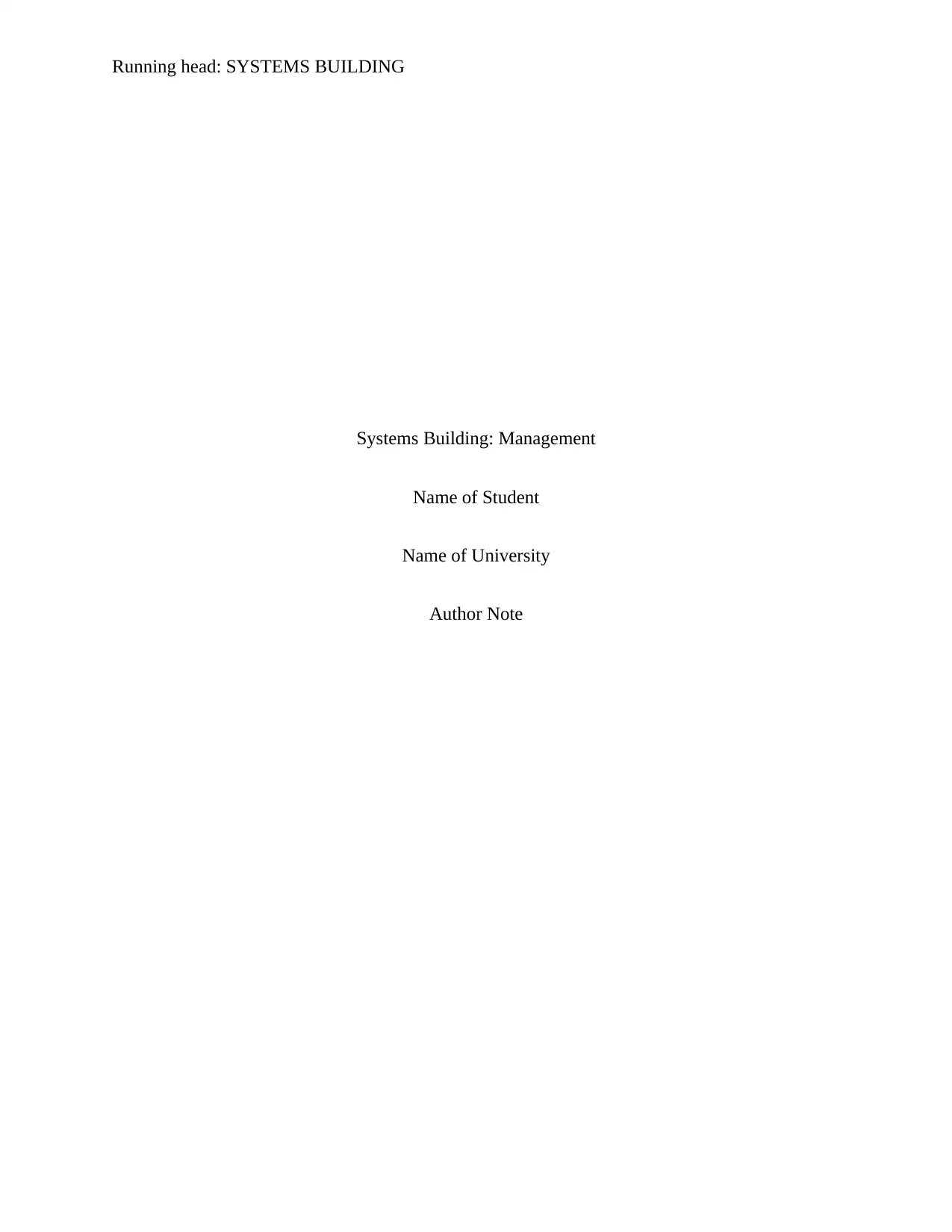
Running head: SYSTEMS BUILDING
Systems Building: Management
Name of Student
Name of University
Author Note
Systems Building: Management
Name of Student
Name of University
Author Note
Secure Best Marks with AI Grader
Need help grading? Try our AI Grader for instant feedback on your assignments.
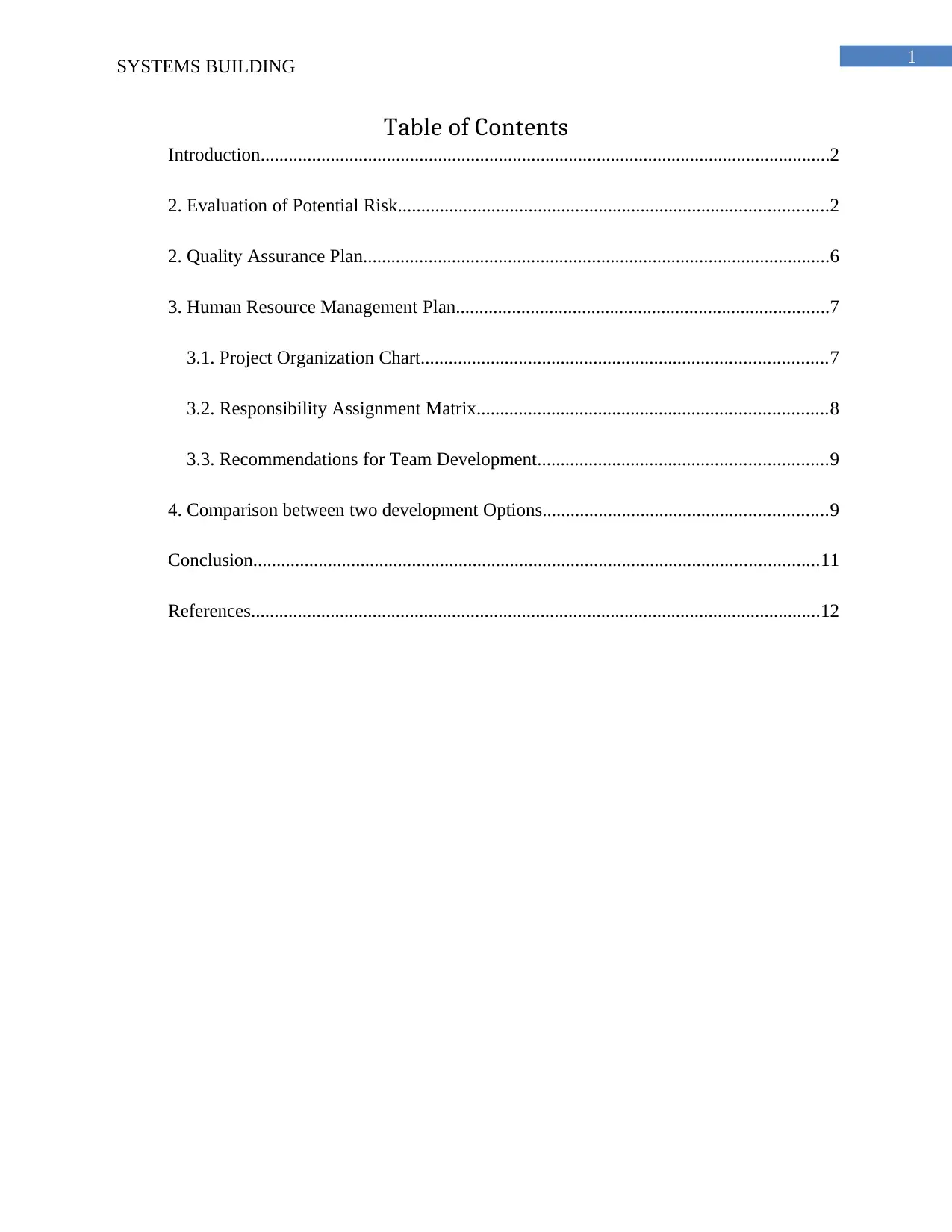
1
SYSTEMS BUILDING
Table of Contents
Introduction..........................................................................................................................2
2. Evaluation of Potential Risk............................................................................................2
2. Quality Assurance Plan....................................................................................................6
3. Human Resource Management Plan................................................................................7
3.1. Project Organization Chart.......................................................................................7
3.2. Responsibility Assignment Matrix...........................................................................8
3.3. Recommendations for Team Development..............................................................9
4. Comparison between two development Options.............................................................9
Conclusion.........................................................................................................................11
References..........................................................................................................................12
SYSTEMS BUILDING
Table of Contents
Introduction..........................................................................................................................2
2. Evaluation of Potential Risk............................................................................................2
2. Quality Assurance Plan....................................................................................................6
3. Human Resource Management Plan................................................................................7
3.1. Project Organization Chart.......................................................................................7
3.2. Responsibility Assignment Matrix...........................................................................8
3.3. Recommendations for Team Development..............................................................9
4. Comparison between two development Options.............................................................9
Conclusion.........................................................................................................................11
References..........................................................................................................................12
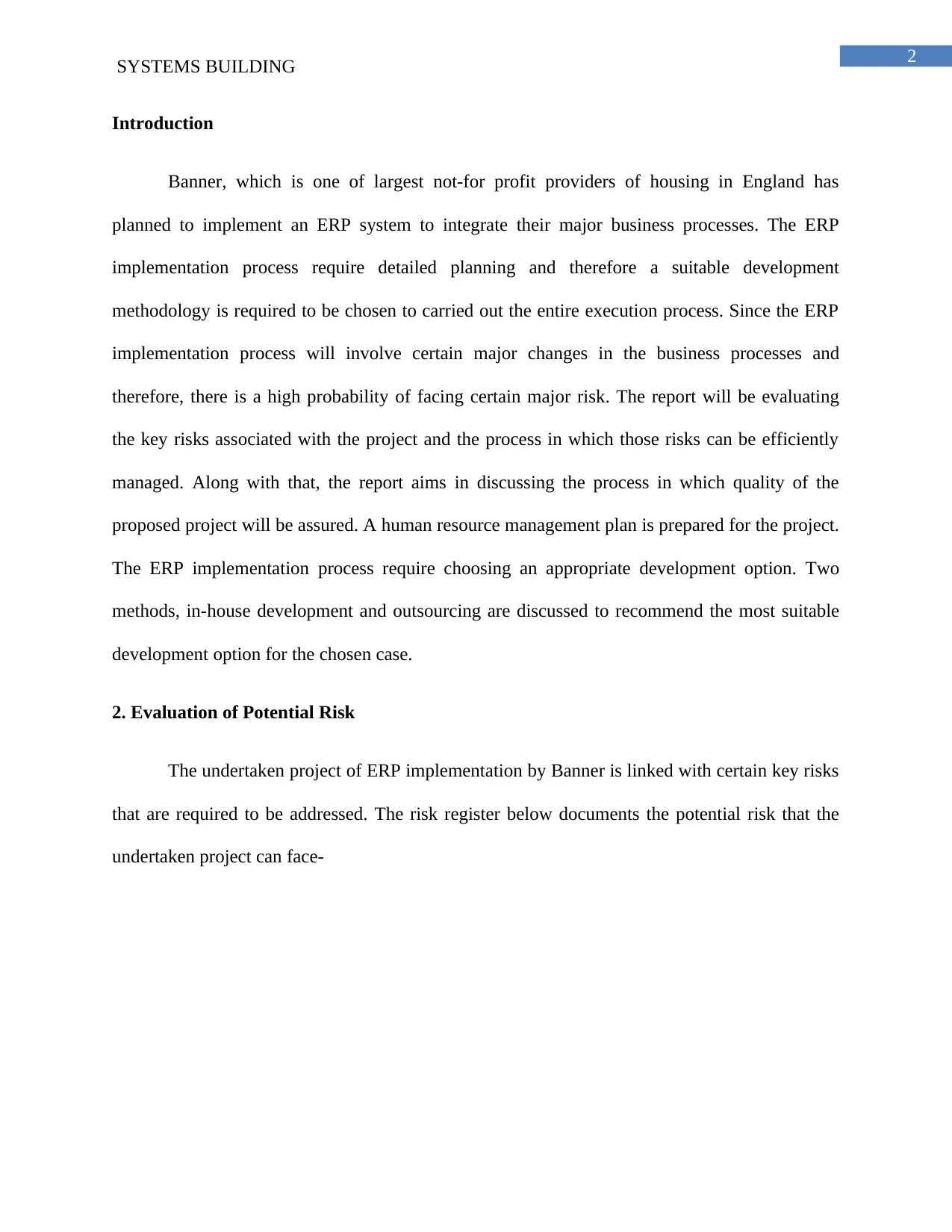
2
SYSTEMS BUILDING
Introduction
Banner, which is one of largest not-for profit providers of housing in England has
planned to implement an ERP system to integrate their major business processes. The ERP
implementation process require detailed planning and therefore a suitable development
methodology is required to be chosen to carried out the entire execution process. Since the ERP
implementation process will involve certain major changes in the business processes and
therefore, there is a high probability of facing certain major risk. The report will be evaluating
the key risks associated with the project and the process in which those risks can be efficiently
managed. Along with that, the report aims in discussing the process in which quality of the
proposed project will be assured. A human resource management plan is prepared for the project.
The ERP implementation process require choosing an appropriate development option. Two
methods, in-house development and outsourcing are discussed to recommend the most suitable
development option for the chosen case.
2. Evaluation of Potential Risk
The undertaken project of ERP implementation by Banner is linked with certain key risks
that are required to be addressed. The risk register below documents the potential risk that the
undertaken project can face-
SYSTEMS BUILDING
Introduction
Banner, which is one of largest not-for profit providers of housing in England has
planned to implement an ERP system to integrate their major business processes. The ERP
implementation process require detailed planning and therefore a suitable development
methodology is required to be chosen to carried out the entire execution process. Since the ERP
implementation process will involve certain major changes in the business processes and
therefore, there is a high probability of facing certain major risk. The report will be evaluating
the key risks associated with the project and the process in which those risks can be efficiently
managed. Along with that, the report aims in discussing the process in which quality of the
proposed project will be assured. A human resource management plan is prepared for the project.
The ERP implementation process require choosing an appropriate development option. Two
methods, in-house development and outsourcing are discussed to recommend the most suitable
development option for the chosen case.
2. Evaluation of Potential Risk
The undertaken project of ERP implementation by Banner is linked with certain key risks
that are required to be addressed. The risk register below documents the potential risk that the
undertaken project can face-
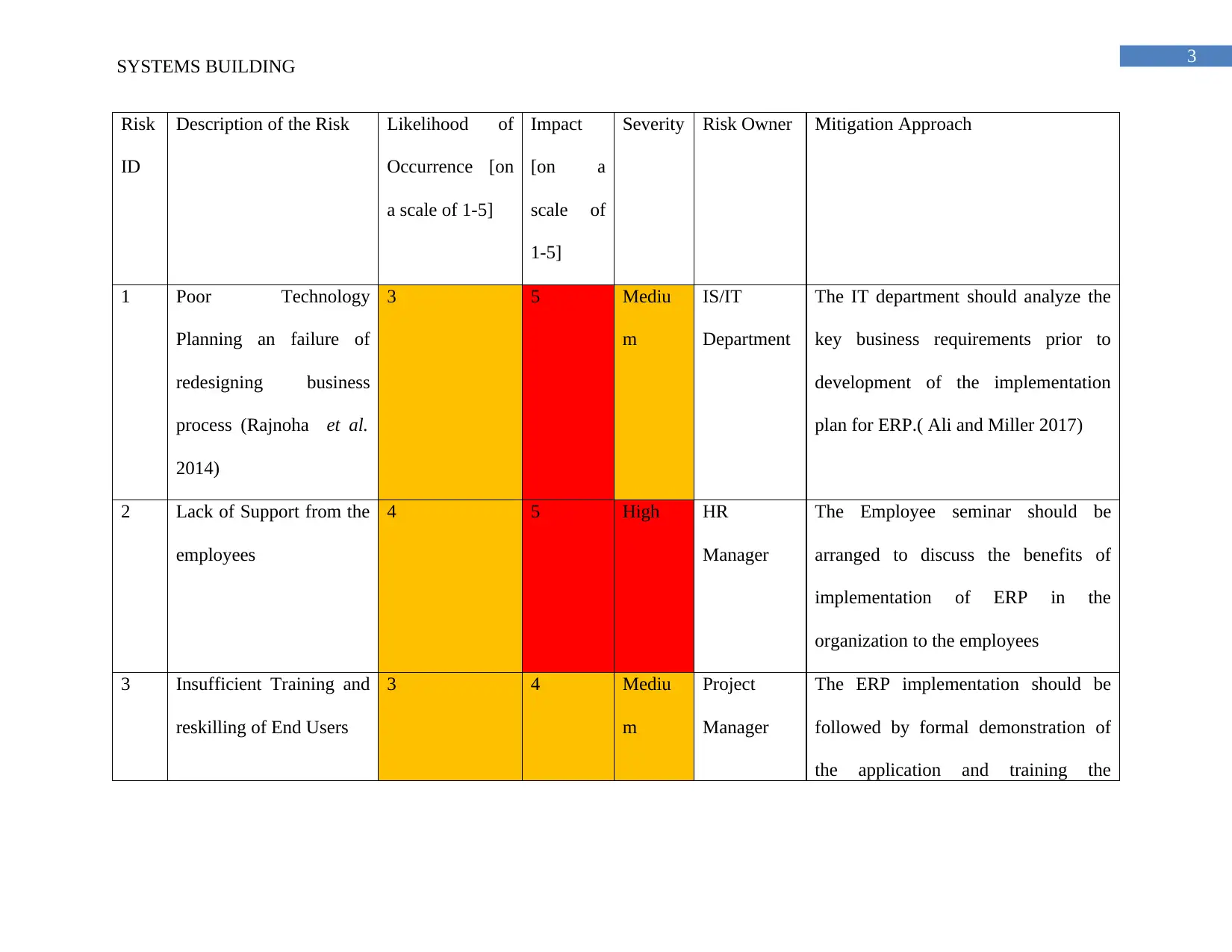
3
SYSTEMS BUILDING
Risk
ID
Description of the Risk Likelihood of
Occurrence [on
a scale of 1-5]
Impact
[on a
scale of
1-5]
Severity Risk Owner Mitigation Approach
1 Poor Technology
Planning an failure of
redesigning business
process (Rajnoha et al.
2014)
3 5 Mediu
m
IS/IT
Department
The IT department should analyze the
key business requirements prior to
development of the implementation
plan for ERP.( Ali and Miller 2017)
2 Lack of Support from the
employees
4 5 High HR
Manager
The Employee seminar should be
arranged to discuss the benefits of
implementation of ERP in the
organization to the employees
3 Insufficient Training and
reskilling of End Users
3 4 Mediu
m
Project
Manager
The ERP implementation should be
followed by formal demonstration of
the application and training the
SYSTEMS BUILDING
Risk
ID
Description of the Risk Likelihood of
Occurrence [on
a scale of 1-5]
Impact
[on a
scale of
1-5]
Severity Risk Owner Mitigation Approach
1 Poor Technology
Planning an failure of
redesigning business
process (Rajnoha et al.
2014)
3 5 Mediu
m
IS/IT
Department
The IT department should analyze the
key business requirements prior to
development of the implementation
plan for ERP.( Ali and Miller 2017)
2 Lack of Support from the
employees
4 5 High HR
Manager
The Employee seminar should be
arranged to discuss the benefits of
implementation of ERP in the
organization to the employees
3 Insufficient Training and
reskilling of End Users
3 4 Mediu
m
Project
Manager
The ERP implementation should be
followed by formal demonstration of
the application and training the
Secure Best Marks with AI Grader
Need help grading? Try our AI Grader for instant feedback on your assignments.
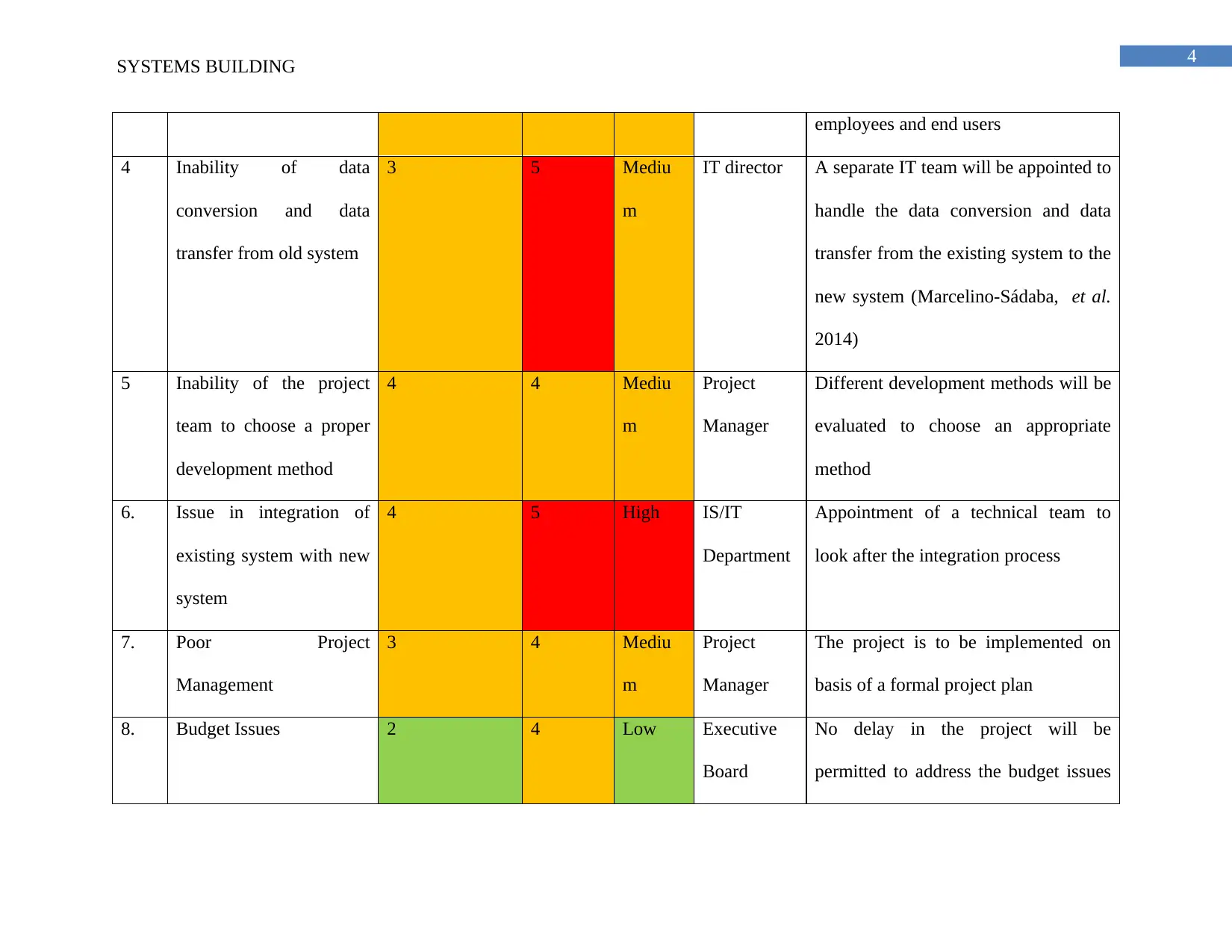
4
SYSTEMS BUILDING
employees and end users
4 Inability of data
conversion and data
transfer from old system
3 5 Mediu
m
IT director A separate IT team will be appointed to
handle the data conversion and data
transfer from the existing system to the
new system (Marcelino-Sádaba, et al.
2014)
5 Inability of the project
team to choose a proper
development method
4 4 Mediu
m
Project
Manager
Different development methods will be
evaluated to choose an appropriate
method
6. Issue in integration of
existing system with new
system
4 5 High IS/IT
Department
Appointment of a technical team to
look after the integration process
7. Poor Project
Management
3 4 Mediu
m
Project
Manager
The project is to be implemented on
basis of a formal project plan
8. Budget Issues 2 4 Low Executive
Board
No delay in the project will be
permitted to address the budget issues
SYSTEMS BUILDING
employees and end users
4 Inability of data
conversion and data
transfer from old system
3 5 Mediu
m
IT director A separate IT team will be appointed to
handle the data conversion and data
transfer from the existing system to the
new system (Marcelino-Sádaba, et al.
2014)
5 Inability of the project
team to choose a proper
development method
4 4 Mediu
m
Project
Manager
Different development methods will be
evaluated to choose an appropriate
method
6. Issue in integration of
existing system with new
system
4 5 High IS/IT
Department
Appointment of a technical team to
look after the integration process
7. Poor Project
Management
3 4 Mediu
m
Project
Manager
The project is to be implemented on
basis of a formal project plan
8. Budget Issues 2 4 Low Executive
Board
No delay in the project will be
permitted to address the budget issues
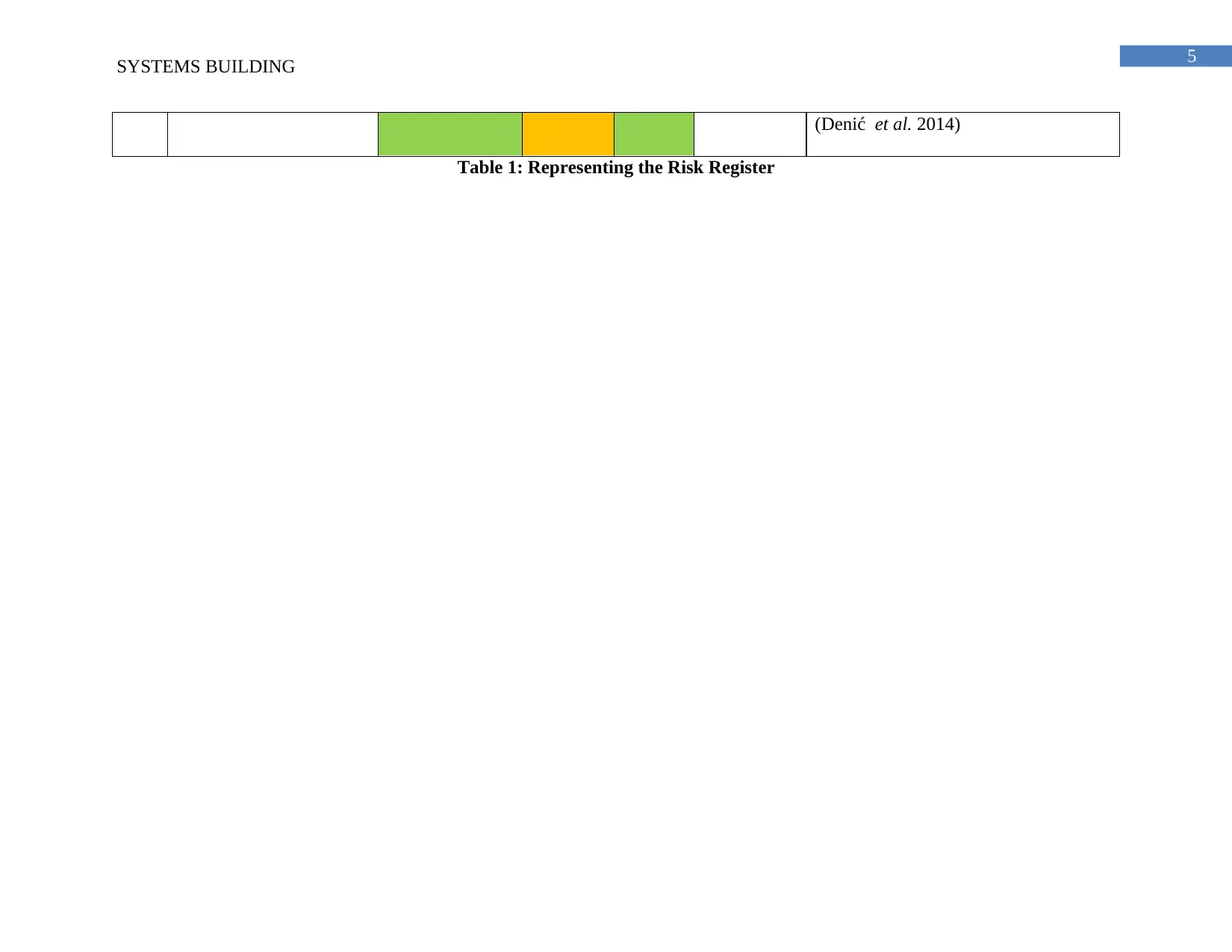
5
SYSTEMS BUILDING
(Denić et al. 2014)
Table 1: Representing the Risk Register
SYSTEMS BUILDING
(Denić et al. 2014)
Table 1: Representing the Risk Register
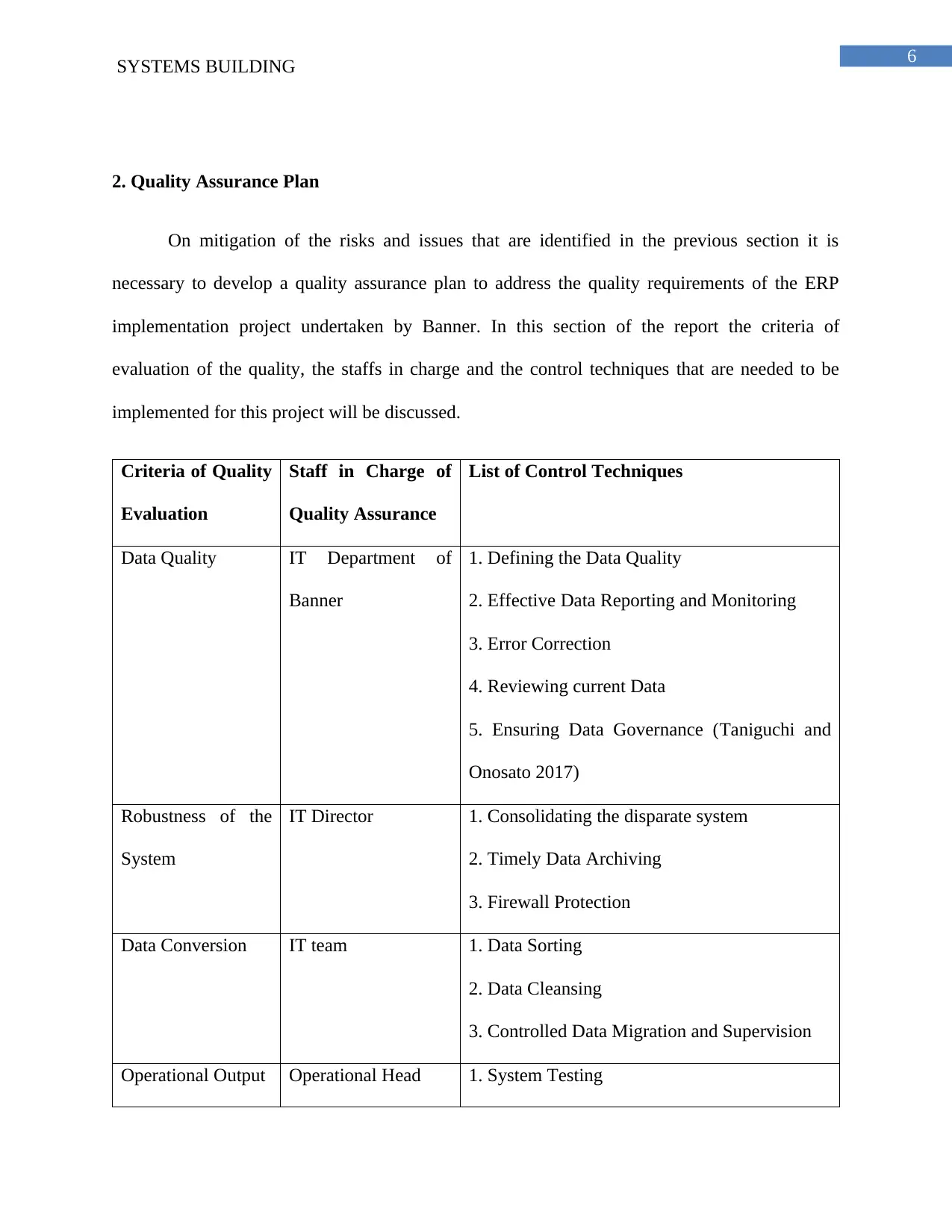
6
SYSTEMS BUILDING
2. Quality Assurance Plan
On mitigation of the risks and issues that are identified in the previous section it is
necessary to develop a quality assurance plan to address the quality requirements of the ERP
implementation project undertaken by Banner. In this section of the report the criteria of
evaluation of the quality, the staffs in charge and the control techniques that are needed to be
implemented for this project will be discussed.
Criteria of Quality
Evaluation
Staff in Charge of
Quality Assurance
List of Control Techniques
Data Quality IT Department of
Banner
1. Defining the Data Quality
2. Effective Data Reporting and Monitoring
3. Error Correction
4. Reviewing current Data
5. Ensuring Data Governance (Taniguchi and
Onosato 2017)
Robustness of the
System
IT Director 1. Consolidating the disparate system
2. Timely Data Archiving
3. Firewall Protection
Data Conversion IT team 1. Data Sorting
2. Data Cleansing
3. Controlled Data Migration and Supervision
Operational Output Operational Head 1. System Testing
SYSTEMS BUILDING
2. Quality Assurance Plan
On mitigation of the risks and issues that are identified in the previous section it is
necessary to develop a quality assurance plan to address the quality requirements of the ERP
implementation project undertaken by Banner. In this section of the report the criteria of
evaluation of the quality, the staffs in charge and the control techniques that are needed to be
implemented for this project will be discussed.
Criteria of Quality
Evaluation
Staff in Charge of
Quality Assurance
List of Control Techniques
Data Quality IT Department of
Banner
1. Defining the Data Quality
2. Effective Data Reporting and Monitoring
3. Error Correction
4. Reviewing current Data
5. Ensuring Data Governance (Taniguchi and
Onosato 2017)
Robustness of the
System
IT Director 1. Consolidating the disparate system
2. Timely Data Archiving
3. Firewall Protection
Data Conversion IT team 1. Data Sorting
2. Data Cleansing
3. Controlled Data Migration and Supervision
Operational Output Operational Head 1. System Testing
Paraphrase This Document
Need a fresh take? Get an instant paraphrase of this document with our AI Paraphraser
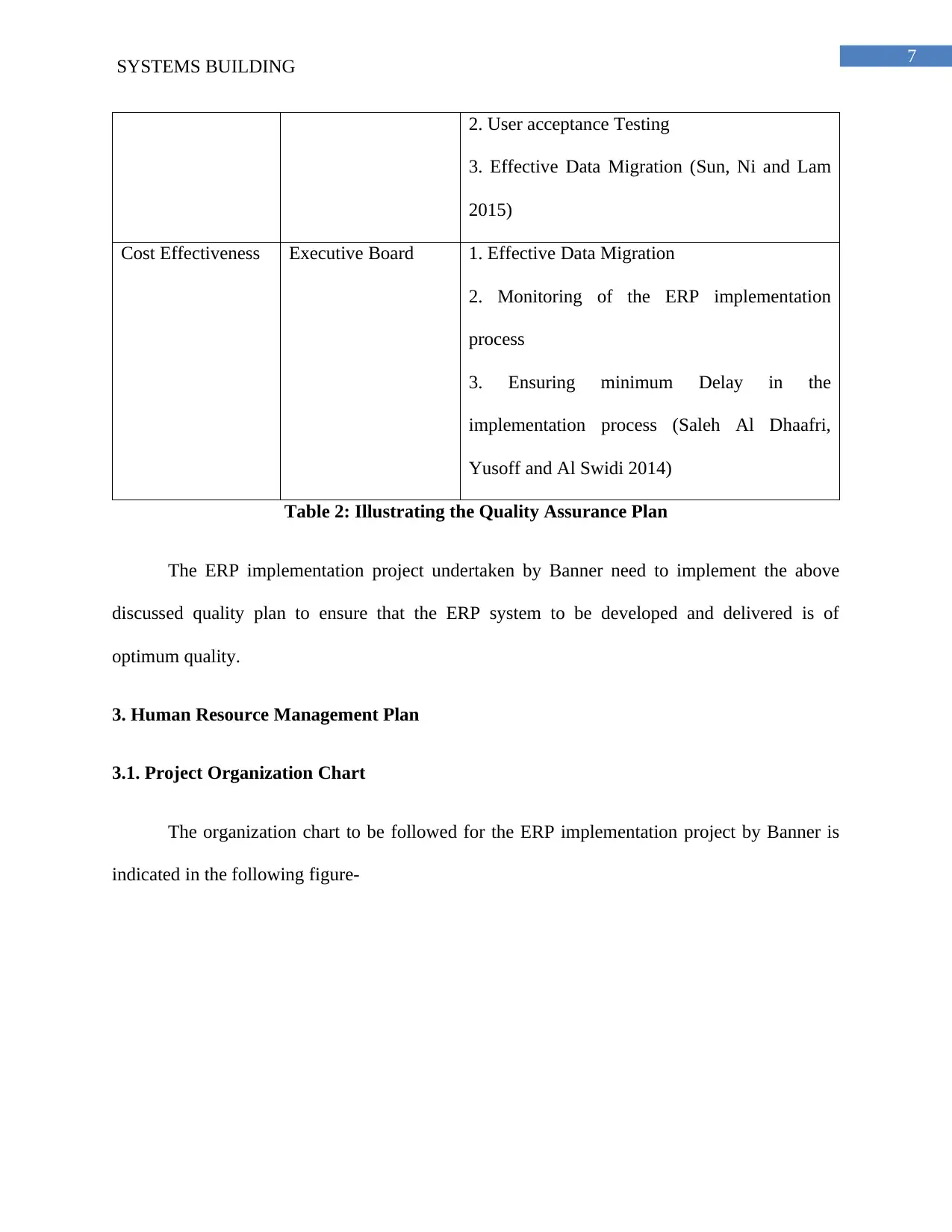
7
SYSTEMS BUILDING
2. User acceptance Testing
3. Effective Data Migration (Sun, Ni and Lam
2015)
Cost Effectiveness Executive Board 1. Effective Data Migration
2. Monitoring of the ERP implementation
process
3. Ensuring minimum Delay in the
implementation process (Saleh Al Dhaafri,
Yusoff and Al Swidi 2014)
Table 2: Illustrating the Quality Assurance Plan
The ERP implementation project undertaken by Banner need to implement the above
discussed quality plan to ensure that the ERP system to be developed and delivered is of
optimum quality.
3. Human Resource Management Plan
3.1. Project Organization Chart
The organization chart to be followed for the ERP implementation project by Banner is
indicated in the following figure-
SYSTEMS BUILDING
2. User acceptance Testing
3. Effective Data Migration (Sun, Ni and Lam
2015)
Cost Effectiveness Executive Board 1. Effective Data Migration
2. Monitoring of the ERP implementation
process
3. Ensuring minimum Delay in the
implementation process (Saleh Al Dhaafri,
Yusoff and Al Swidi 2014)
Table 2: Illustrating the Quality Assurance Plan
The ERP implementation project undertaken by Banner need to implement the above
discussed quality plan to ensure that the ERP system to be developed and delivered is of
optimum quality.
3. Human Resource Management Plan
3.1. Project Organization Chart
The organization chart to be followed for the ERP implementation project by Banner is
indicated in the following figure-
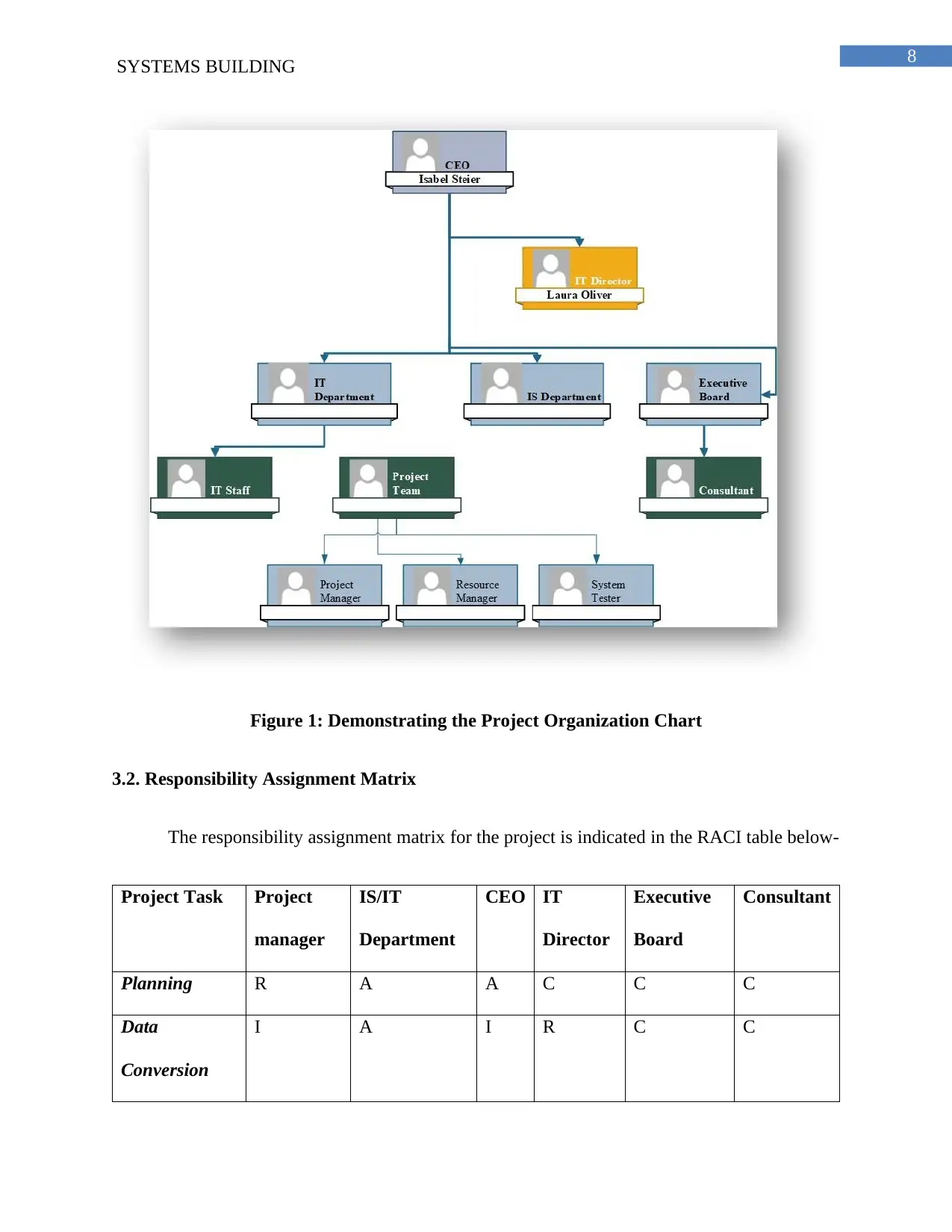
8
SYSTEMS BUILDING
Figure 1: Demonstrating the Project Organization Chart
3.2. Responsibility Assignment Matrix
The responsibility assignment matrix for the project is indicated in the RACI table below-
Project Task Project
manager
IS/IT
Department
CEO IT
Director
Executive
Board
Consultant
Planning R A A C C C
Data
Conversion
I A I R C C
SYSTEMS BUILDING
Figure 1: Demonstrating the Project Organization Chart
3.2. Responsibility Assignment Matrix
The responsibility assignment matrix for the project is indicated in the RACI table below-
Project Task Project
manager
IS/IT
Department
CEO IT
Director
Executive
Board
Consultant
Planning R A A C C C
Data
Conversion
I A I R C C
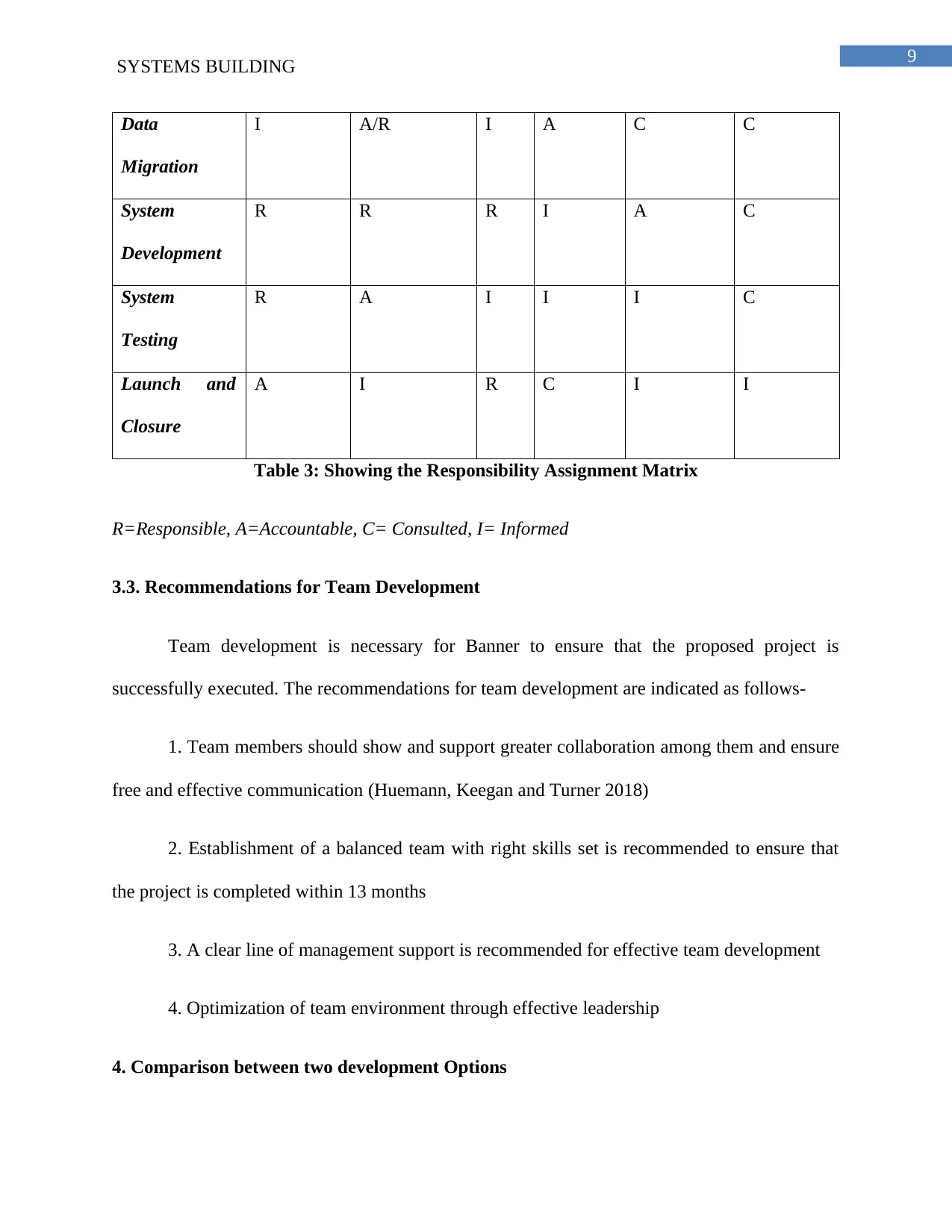
9
SYSTEMS BUILDING
Data
Migration
I A/R I A C C
System
Development
R R R I A C
System
Testing
R A I I I C
Launch and
Closure
A I R C I I
Table 3: Showing the Responsibility Assignment Matrix
R=Responsible, A=Accountable, C= Consulted, I= Informed
3.3. Recommendations for Team Development
Team development is necessary for Banner to ensure that the proposed project is
successfully executed. The recommendations for team development are indicated as follows-
1. Team members should show and support greater collaboration among them and ensure
free and effective communication (Huemann, Keegan and Turner 2018)
2. Establishment of a balanced team with right skills set is recommended to ensure that
the project is completed within 13 months
3. A clear line of management support is recommended for effective team development
4. Optimization of team environment through effective leadership
4. Comparison between two development Options
SYSTEMS BUILDING
Data
Migration
I A/R I A C C
System
Development
R R R I A C
System
Testing
R A I I I C
Launch and
Closure
A I R C I I
Table 3: Showing the Responsibility Assignment Matrix
R=Responsible, A=Accountable, C= Consulted, I= Informed
3.3. Recommendations for Team Development
Team development is necessary for Banner to ensure that the proposed project is
successfully executed. The recommendations for team development are indicated as follows-
1. Team members should show and support greater collaboration among them and ensure
free and effective communication (Huemann, Keegan and Turner 2018)
2. Establishment of a balanced team with right skills set is recommended to ensure that
the project is completed within 13 months
3. A clear line of management support is recommended for effective team development
4. Optimization of team environment through effective leadership
4. Comparison between two development Options
Secure Best Marks with AI Grader
Need help grading? Try our AI Grader for instant feedback on your assignments.
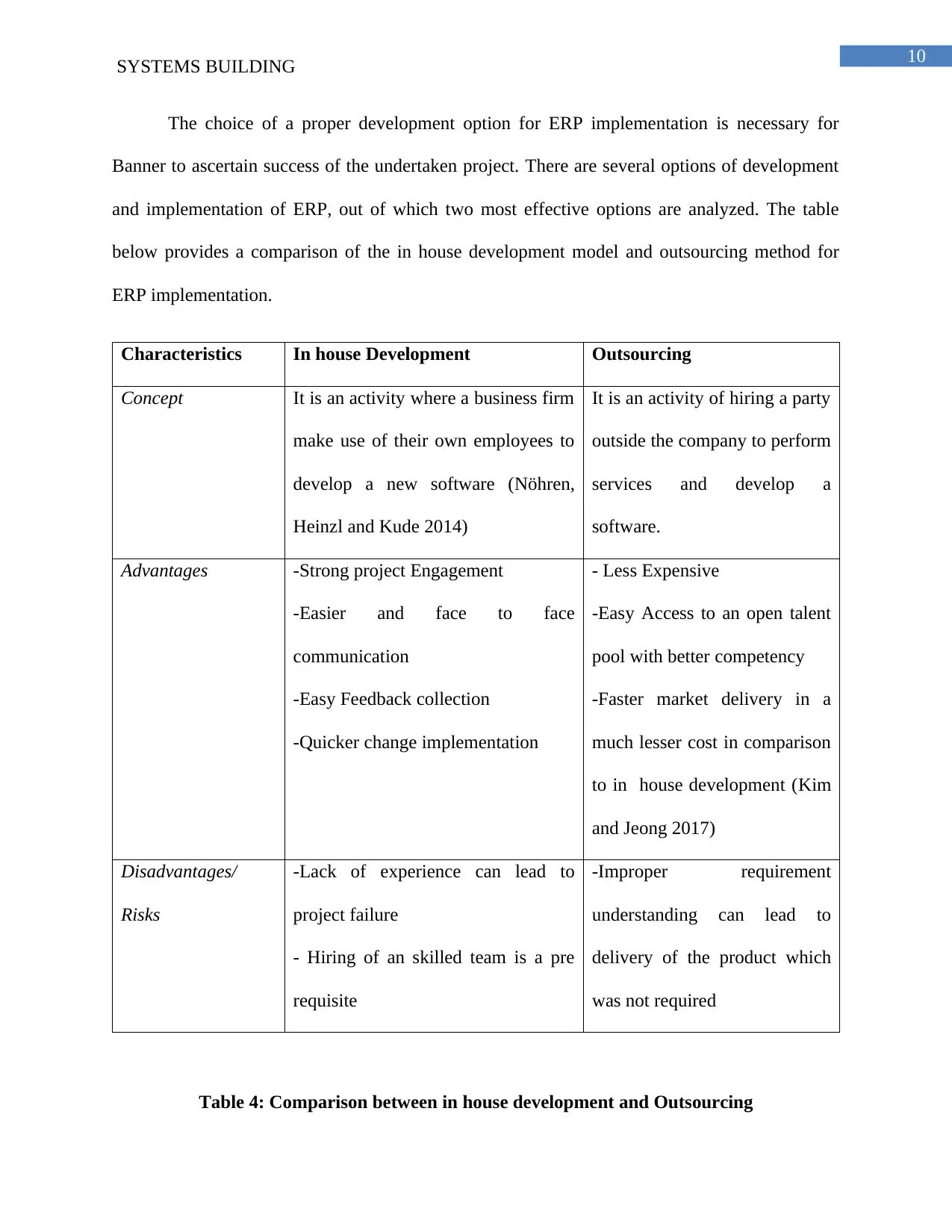
10
SYSTEMS BUILDING
The choice of a proper development option for ERP implementation is necessary for
Banner to ascertain success of the undertaken project. There are several options of development
and implementation of ERP, out of which two most effective options are analyzed. The table
below provides a comparison of the in house development model and outsourcing method for
ERP implementation.
Characteristics In house Development Outsourcing
Concept It is an activity where a business firm
make use of their own employees to
develop a new software (Nöhren,
Heinzl and Kude 2014)
It is an activity of hiring a party
outside the company to perform
services and develop a
software.
Advantages -Strong project Engagement
-Easier and face to face
communication
-Easy Feedback collection
-Quicker change implementation
- Less Expensive
-Easy Access to an open talent
pool with better competency
-Faster market delivery in a
much lesser cost in comparison
to in house development (Kim
and Jeong 2017)
Disadvantages/
Risks
-Lack of experience can lead to
project failure
- Hiring of an skilled team is a pre
requisite
-Improper requirement
understanding can lead to
delivery of the product which
was not required
Table 4: Comparison between in house development and Outsourcing
SYSTEMS BUILDING
The choice of a proper development option for ERP implementation is necessary for
Banner to ascertain success of the undertaken project. There are several options of development
and implementation of ERP, out of which two most effective options are analyzed. The table
below provides a comparison of the in house development model and outsourcing method for
ERP implementation.
Characteristics In house Development Outsourcing
Concept It is an activity where a business firm
make use of their own employees to
develop a new software (Nöhren,
Heinzl and Kude 2014)
It is an activity of hiring a party
outside the company to perform
services and develop a
software.
Advantages -Strong project Engagement
-Easier and face to face
communication
-Easy Feedback collection
-Quicker change implementation
- Less Expensive
-Easy Access to an open talent
pool with better competency
-Faster market delivery in a
much lesser cost in comparison
to in house development (Kim
and Jeong 2017)
Disadvantages/
Risks
-Lack of experience can lead to
project failure
- Hiring of an skilled team is a pre
requisite
-Improper requirement
understanding can lead to
delivery of the product which
was not required
Table 4: Comparison between in house development and Outsourcing
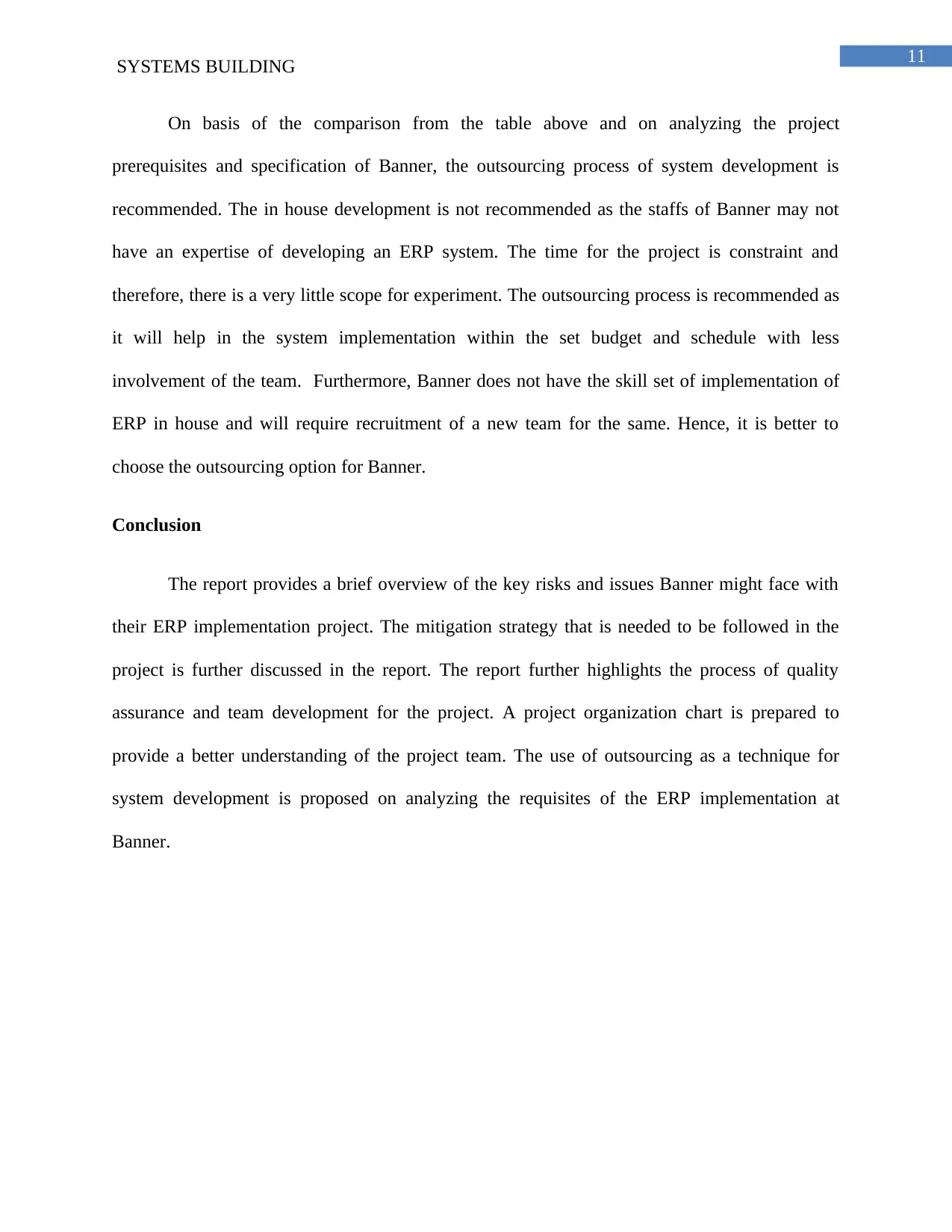
11
SYSTEMS BUILDING
On basis of the comparison from the table above and on analyzing the project
prerequisites and specification of Banner, the outsourcing process of system development is
recommended. The in house development is not recommended as the staffs of Banner may not
have an expertise of developing an ERP system. The time for the project is constraint and
therefore, there is a very little scope for experiment. The outsourcing process is recommended as
it will help in the system implementation within the set budget and schedule with less
involvement of the team. Furthermore, Banner does not have the skill set of implementation of
ERP in house and will require recruitment of a new team for the same. Hence, it is better to
choose the outsourcing option for Banner.
Conclusion
The report provides a brief overview of the key risks and issues Banner might face with
their ERP implementation project. The mitigation strategy that is needed to be followed in the
project is further discussed in the report. The report further highlights the process of quality
assurance and team development for the project. A project organization chart is prepared to
provide a better understanding of the project team. The use of outsourcing as a technique for
system development is proposed on analyzing the requisites of the ERP implementation at
Banner.
SYSTEMS BUILDING
On basis of the comparison from the table above and on analyzing the project
prerequisites and specification of Banner, the outsourcing process of system development is
recommended. The in house development is not recommended as the staffs of Banner may not
have an expertise of developing an ERP system. The time for the project is constraint and
therefore, there is a very little scope for experiment. The outsourcing process is recommended as
it will help in the system implementation within the set budget and schedule with less
involvement of the team. Furthermore, Banner does not have the skill set of implementation of
ERP in house and will require recruitment of a new team for the same. Hence, it is better to
choose the outsourcing option for Banner.
Conclusion
The report provides a brief overview of the key risks and issues Banner might face with
their ERP implementation project. The mitigation strategy that is needed to be followed in the
project is further discussed in the report. The report further highlights the process of quality
assurance and team development for the project. A project organization chart is prepared to
provide a better understanding of the project team. The use of outsourcing as a technique for
system development is proposed on analyzing the requisites of the ERP implementation at
Banner.
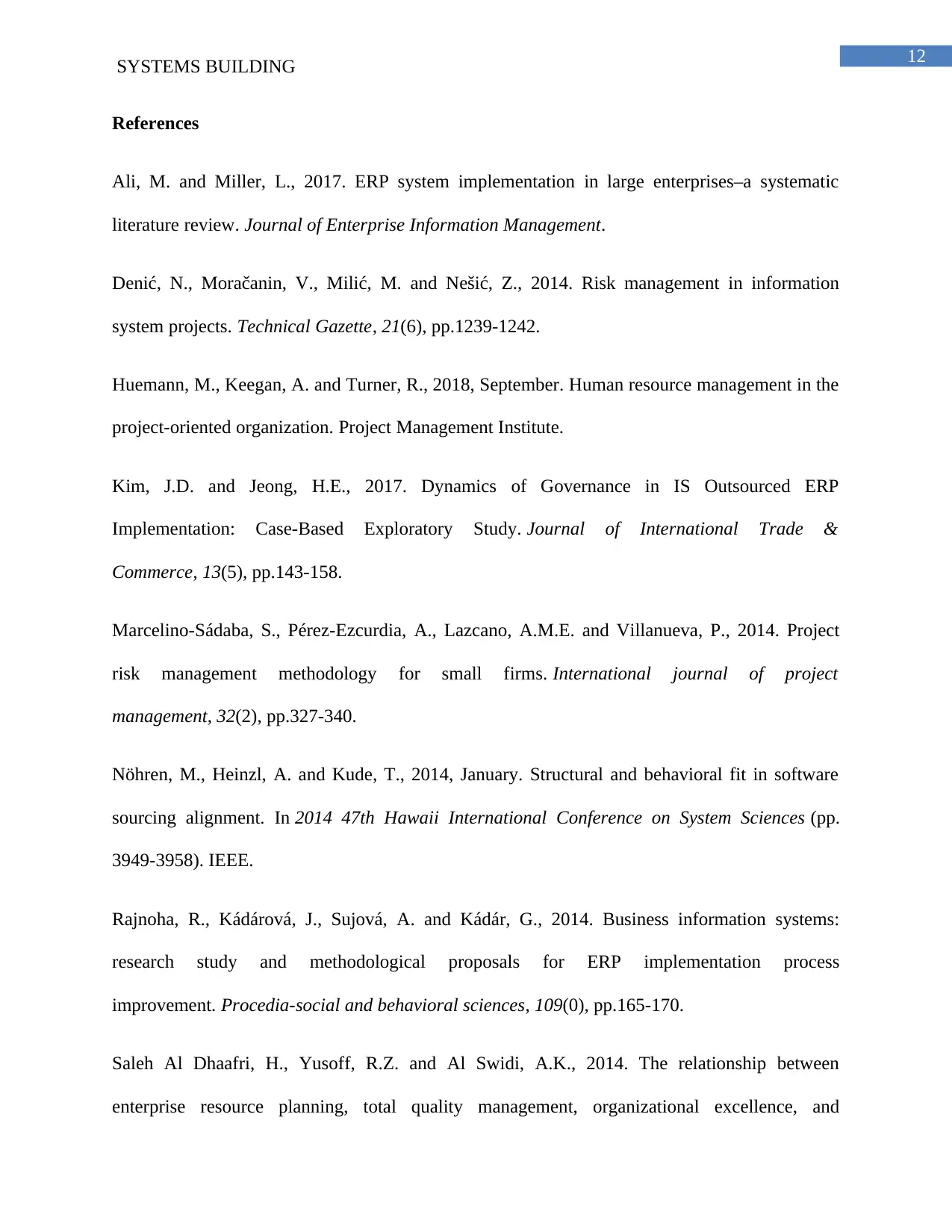
12
SYSTEMS BUILDING
References
Ali, M. and Miller, L., 2017. ERP system implementation in large enterprises–a systematic
literature review. Journal of Enterprise Information Management.
Denić, N., Moračanin, V., Milić, M. and Nešić, Z., 2014. Risk management in information
system projects. Technical Gazette, 21(6), pp.1239-1242.
Huemann, M., Keegan, A. and Turner, R., 2018, September. Human resource management in the
project-oriented organization. Project Management Institute.
Kim, J.D. and Jeong, H.E., 2017. Dynamics of Governance in IS Outsourced ERP
Implementation: Case-Based Exploratory Study. Journal of International Trade &
Commerce, 13(5), pp.143-158.
Marcelino-Sádaba, S., Pérez-Ezcurdia, A., Lazcano, A.M.E. and Villanueva, P., 2014. Project
risk management methodology for small firms. International journal of project
management, 32(2), pp.327-340.
Nöhren, M., Heinzl, A. and Kude, T., 2014, January. Structural and behavioral fit in software
sourcing alignment. In 2014 47th Hawaii International Conference on System Sciences (pp.
3949-3958). IEEE.
Rajnoha, R., Kádárová, J., Sujová, A. and Kádár, G., 2014. Business information systems:
research study and methodological proposals for ERP implementation process
improvement. Procedia-social and behavioral sciences, 109(0), pp.165-170.
Saleh Al Dhaafri, H., Yusoff, R.Z. and Al Swidi, A.K., 2014. The relationship between
enterprise resource planning, total quality management, organizational excellence, and
SYSTEMS BUILDING
References
Ali, M. and Miller, L., 2017. ERP system implementation in large enterprises–a systematic
literature review. Journal of Enterprise Information Management.
Denić, N., Moračanin, V., Milić, M. and Nešić, Z., 2014. Risk management in information
system projects. Technical Gazette, 21(6), pp.1239-1242.
Huemann, M., Keegan, A. and Turner, R., 2018, September. Human resource management in the
project-oriented organization. Project Management Institute.
Kim, J.D. and Jeong, H.E., 2017. Dynamics of Governance in IS Outsourced ERP
Implementation: Case-Based Exploratory Study. Journal of International Trade &
Commerce, 13(5), pp.143-158.
Marcelino-Sádaba, S., Pérez-Ezcurdia, A., Lazcano, A.M.E. and Villanueva, P., 2014. Project
risk management methodology for small firms. International journal of project
management, 32(2), pp.327-340.
Nöhren, M., Heinzl, A. and Kude, T., 2014, January. Structural and behavioral fit in software
sourcing alignment. In 2014 47th Hawaii International Conference on System Sciences (pp.
3949-3958). IEEE.
Rajnoha, R., Kádárová, J., Sujová, A. and Kádár, G., 2014. Business information systems:
research study and methodological proposals for ERP implementation process
improvement. Procedia-social and behavioral sciences, 109(0), pp.165-170.
Saleh Al Dhaafri, H., Yusoff, R.Z. and Al Swidi, A.K., 2014. The relationship between
enterprise resource planning, total quality management, organizational excellence, and
Paraphrase This Document
Need a fresh take? Get an instant paraphrase of this document with our AI Paraphraser
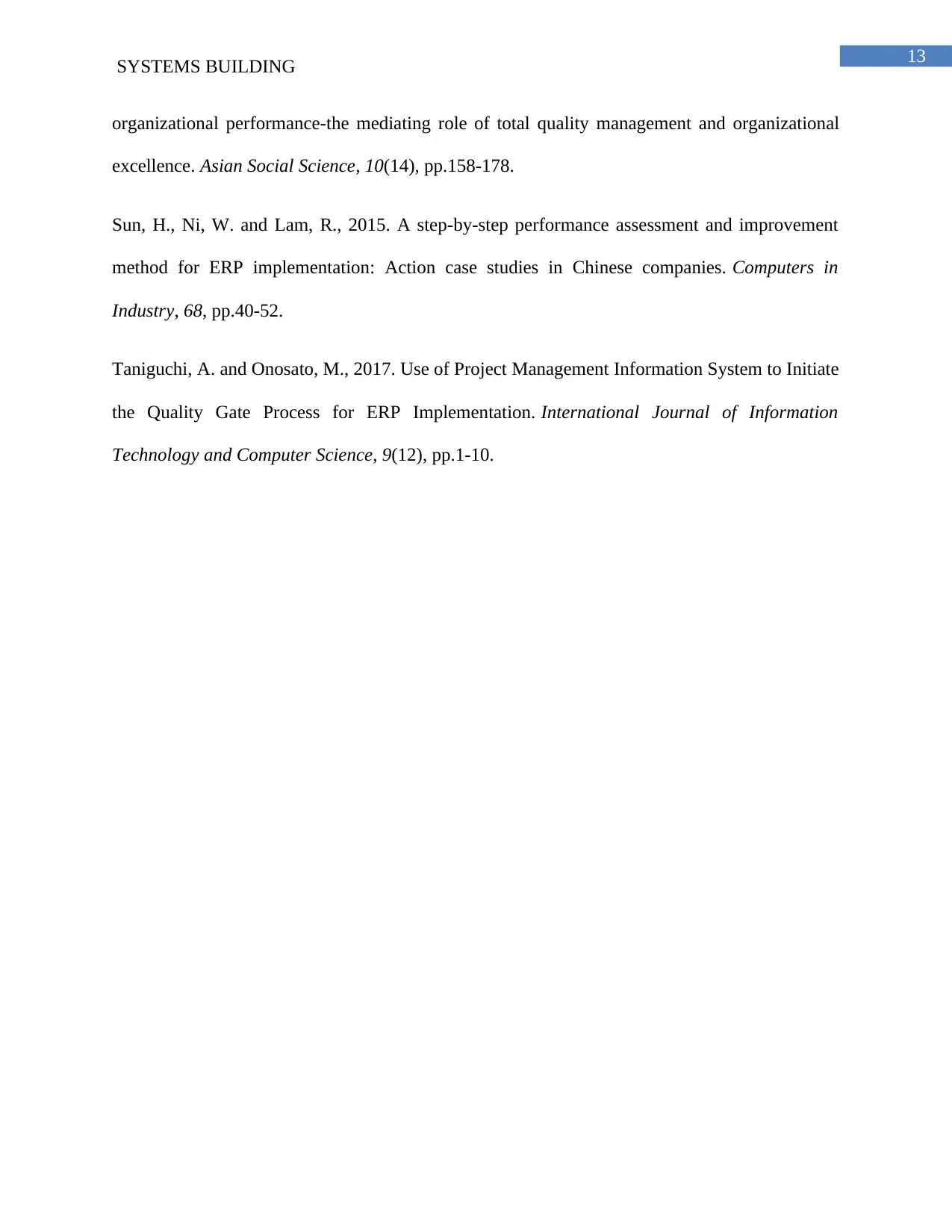
13
SYSTEMS BUILDING
organizational performance-the mediating role of total quality management and organizational
excellence. Asian Social Science, 10(14), pp.158-178.
Sun, H., Ni, W. and Lam, R., 2015. A step-by-step performance assessment and improvement
method for ERP implementation: Action case studies in Chinese companies. Computers in
Industry, 68, pp.40-52.
Taniguchi, A. and Onosato, M., 2017. Use of Project Management Information System to Initiate
the Quality Gate Process for ERP Implementation. International Journal of Information
Technology and Computer Science, 9(12), pp.1-10.
SYSTEMS BUILDING
organizational performance-the mediating role of total quality management and organizational
excellence. Asian Social Science, 10(14), pp.158-178.
Sun, H., Ni, W. and Lam, R., 2015. A step-by-step performance assessment and improvement
method for ERP implementation: Action case studies in Chinese companies. Computers in
Industry, 68, pp.40-52.
Taniguchi, A. and Onosato, M., 2017. Use of Project Management Information System to Initiate
the Quality Gate Process for ERP Implementation. International Journal of Information
Technology and Computer Science, 9(12), pp.1-10.
1 out of 14
Related Documents
Your All-in-One AI-Powered Toolkit for Academic Success.
+13062052269
info@desklib.com
Available 24*7 on WhatsApp / Email
![[object Object]](/_next/static/media/star-bottom.7253800d.svg)
Unlock your academic potential
© 2024 | Zucol Services PVT LTD | All rights reserved.





